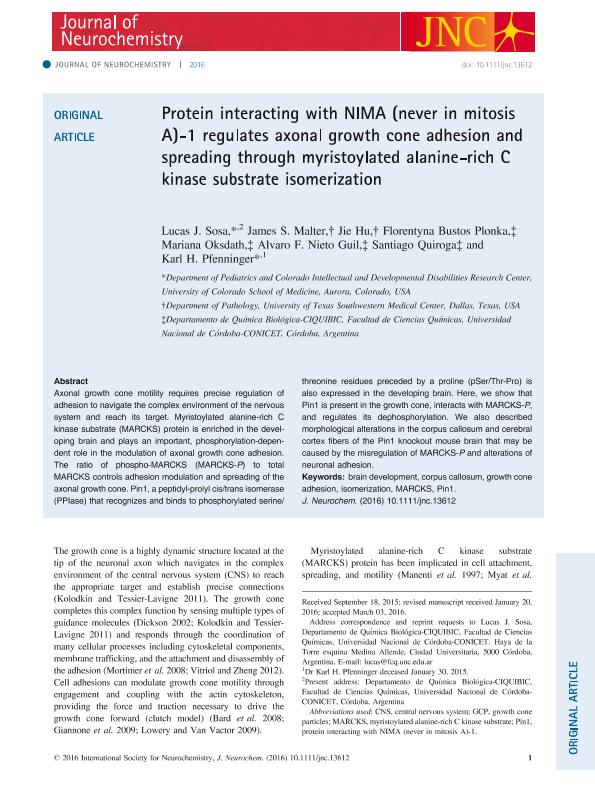Artículo
Protein interacting with NIMA (never in mitosis A)-1 regulates axonal growth cone adhesion and spreading through myristoylated alanine-rich C kinase substrate isomerization
Sosa, Lucas Javier ; Malter, James S.; Hu, Jie; Bustos Plonka, Florentina; Oksdath Mansilla, Mariana
; Malter, James S.; Hu, Jie; Bustos Plonka, Florentina; Oksdath Mansilla, Mariana ; Nieto Guil, Alvaro Fernando
; Nieto Guil, Alvaro Fernando ; Quiroga, Santiago
; Quiroga, Santiago ; Pfenninger, Karl H.
; Pfenninger, Karl H.
 ; Malter, James S.; Hu, Jie; Bustos Plonka, Florentina; Oksdath Mansilla, Mariana
; Malter, James S.; Hu, Jie; Bustos Plonka, Florentina; Oksdath Mansilla, Mariana ; Nieto Guil, Alvaro Fernando
; Nieto Guil, Alvaro Fernando ; Quiroga, Santiago
; Quiroga, Santiago ; Pfenninger, Karl H.
; Pfenninger, Karl H.
Fecha de publicación:
06/2016
Editorial:
Wiley Blackwell Publishing, Inc
Revista:
Journal of Neurochemistry
ISSN:
0022-3042
e-ISSN:
1471-4159
Idioma:
Inglés
Tipo de recurso:
Artículo publicado
Clasificación temática:
Resumen
Axonal growth cone motility requires precise regulation of adhesion to navigate the complex environment of the nervous system and reach its target. Myristoylated alanine-rich C kinase substrate (MARCKS) protein is enriched in the developing brain and plays an important, phosphorylation-dependent role in the modulation of axonal growth cone adhesion. The ratio of phospho-MARCKS (MARCKS-P) to total MARCKS controls adhesion modulation and spreading of the axonal growth cone. Pin1, a peptidyl-prolyl cis/trans isomerase (PPIase) that recognizes and binds to phosphorylated serine/threonine residues preceded by a proline (pSer/Thr-Pro) is also expressed in the developing brain. Here, we show that Pin1 is present in the growth cone, interacts with MARCKS-P, and regulates its dephosphorylation. We also described morphological alterations in the corpus callosum and cerebral cortex fibers of the Pin1 knockout mouse brain that may be caused by the misregulation of MARCKS-P and alterations of neuronal adhesion. We have shown that MARCKS, a critical protein in the movement of neuronal growth cones, is in turn regulated by both phosphorylation and cis-trans peptidyl isomerization mediated by Pin1. In the absence of Pin1, MARCKS is hyperphosphorylated, leading to loss of adhesions, and collapse of the growth cone. The Pin1 KO mice exhibited disturbed neuronal projections from the cerebral cortex and reduced white matter tracks such as the corpus callosum. This study highlights a novel function of Pin1 in neurodevelopment. We have shown that MARCKS, a critical protein in the movement of neuronal growth cones, is in turn regulated by both phosphorylation and cis-trans peptidyl isomerization mediated by Pin1. In the absence of Pin1, MARCKS is hyperphosphorylated, leading to loss of adhesions, and collapse of the growth cone. The Pin1 KO mice exhibited disturbed neuronal projections from the cerebral cortex and reduced white matter tracks such as the corpus callosum. This study highlights a novel function of Pin1 in neurodevelopment.
Archivos asociados
Licencia
Identificadores
Colecciones
Articulos(CIQUIBIC)
Articulos de CENTRO DE INVEST.EN QCA.BIOL.DE CORDOBA (P)
Articulos de CENTRO DE INVEST.EN QCA.BIOL.DE CORDOBA (P)
Citación
Sosa, Lucas Javier; Malter, James S.; Hu, Jie; Bustos Plonka, Florentina; Oksdath Mansilla, Mariana; et al.; Protein interacting with NIMA (never in mitosis A)-1 regulates axonal growth cone adhesion and spreading through myristoylated alanine-rich C kinase substrate isomerization; Wiley Blackwell Publishing, Inc; Journal of Neurochemistry; 137; 5; 6-2016; 744-755
Compartir
Altmétricas



